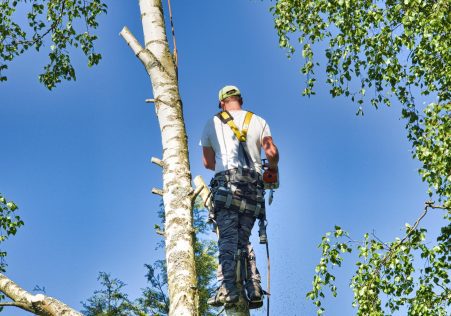The Expert's Checklist: How to Determine if a Tree Requires to be Cut Down

Tree removal is a difficult and possibly dangerous job. If a tree has died, diseased, or at risk of falling, it could require removal to avoid damage to the property and to ensure safety. But how can you tell when a tree must be cut down? In this article, we’ll walk you through the signs to be looking to and assist you determine whether it’s time to call in the experts.
Dead or dying trees
One of the evident signs that a tree must be taken down is if it’s dying or dead. Dead trees are without leaves and can have a lifeless appearance. If a tree is without leaves or any signs of growth, it is likely dead. In addition, the bark of dead trees may be dry, cracked or peeling.
Diseased Trees
Diseased trees can pose a threat to other plants and trees in the surrounding area. The most common signs of disease for trees include the appearance of yellowing leaves, wilted branches, and mushroom growth at the root and the top. If you suspect that your tree may be diseased It is essential to get it checked by an arborist who is a professional.
Leaning Trees
Trees that lean to one side may be a sign that the root system is failing, and the tree may be at risk of falling. To identify if a leaning tree could be a threat, check for cracks or broken areas in the trunk, and then look at the soil at the base of the tree. If you notice any of these indicators, it’s best to get the tree examined by an arborist.
Overhanging Branches
Overhanging branches of trees located close to buildings or power lines could pose a threat to safety and property. If you have concerns regarding branches that hang overhanging It is recommended to have the tree evaluated by an arborist who can determine if removal or trimming is required.
FAQs
What can I do to tell if a tree is dead?
The tree will be considered to be dead if it lacks leaves and has no signs of new growth. Additionally, the bark of a dead tree can be dry, cracked, or peeling.
What are the warning signs of a tree that is diseased?
The most common signs of disease in trees include yellowing leaves, wilted branches, and mushroom growth at the at the base of the tree.
Is it safe to take down a tree yourself?
Tree removal is a complex and possibly dangerous job. It’s best to leave it to experts who can ensure the safety of yourself and others.
Conclusion
When it comes to tree removal, you need to be aware of the indications that a tree should be removed. When you’re aware of indicators of dying or dead trees, sick trees, tree leaning, and hanging branches and overhanging branches, you can take the necessary steps to ensure the safety of your property and the people around you. If you suspect that there is a tree in your yard that requires removal do not hesitate to contact Sydney Eastern Suburbs Tree Lopping for a professional assessment. Our highly trained arborists are equipped with the knowledge and experience to meet your tree removal needs. Don’t take any chances with your safety. If you suspect that a tree on your property must be removed, call Sydney Eastern Suburbs Tree Lopping today for a professional evaluation. Our experienced arborists can provide you with peace of mind which comes from knowing that your property is in good hands. Call us now to 1300 514 819 to schedule an appointment.





















